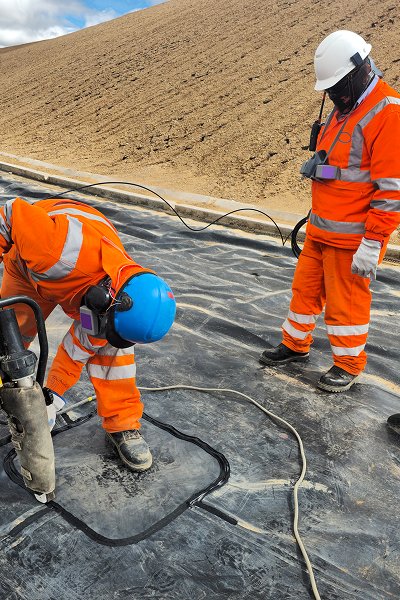What is GCL (Geosynthetic Clay Liner) ?
GCL (Geosynthetic Clay Liner) is a waterproof layer composed of high-expansion sodium-based bentonite as the main seepage prevention material and combined with geotextiles or geomembranes.
Top layer: Nonwoven geotextile, used to absorb and protect bentonite.
Middle layer: Sodium bentonite, the main impermeable medium.
Bottom layer: Woven fabric or HDPE membrane, used for structural support and to prevent bentonite loss.


Material properties and performance advantages of GCL
Superior impermeability; GCL's permeability coefficient can be as low as 1×10⁻¹¹ m/s, approaching or even surpassing that of natural clay layers. This performance stems from the dense gel layer formed by bentonite after absorbing water, which effectively prevents the penetration of liquids and gases.
Self-healing and regeneration capabilities; When micro-cracks appear in GCL due to external forces, the bentonite automatically absorbs water and expands to repair the cracks. This "self-healing" property makes it more reliable in long-term operation, particularly suitable for areas where the impermeable layer is affected by small displacements.
Simple construction and short construction period; Unlike thick clay layers, GCL rolls are lightweight and can be laid mechanically, saving construction time and labor costs. Thousands of square meters can typically be laid per shift, significantly improving construction efficiency.
Environmentally friendly and non-toxic; Bentonite is a natural mineral, free of harmful components, and environmentally friendly to groundwater and soil, meeting environmental engineering standards.
Stability and durability; GCL exhibits excellent chemical stability, resisting acid and alkali corrosion, salt crystallization, and freeze-thaw cycles, adapting to various climatic conditions. Experiments have shown that its seepage prevention performance can be maintained stably for more than 50 years.
Comparison Between GCL and Traditional Impermeable Materials
| Comparison Item | GCL (Geosynthetic Clay Liner) | Traditional Clay Layer | HDPE Geomembrane |
|---|---|---|---|
| Thickness | 5–10 mm | 30–100 cm | 0.5–2.0 mm |
| Permeability Coefficient | ≤ 1×10⁻¹¹ m/s | 1×10⁻⁹ – 1×10⁻¹⁰ m/s | ≤ 1×10⁻¹³ m/s |
| Installation Speed | Fast and easy (roll installation) | Slow and labor-intensive | Moderate |
| Self-healing Ability | Excellent (due to bentonite swelling) | Average | None |
| Durability | Good resistance to chemical and environmental stress | Limited | Excellent under UV and chemical exposure |
| Cost | Medium | High (due to excavation and transportation) | High |
| Environmental Impact | Eco-friendly, natural bentonite | High environmental impact | Requires polymer manufacturing |
| Maintenance | Low, minimal post-installation care | High | Low |
| Typical Applications | Landfill liners, ponds, reservoirs, tunnels | Dams, canals, land reclamation | Landfills, mining ponds, oil containment |
GCL Application Scenarios
Landfill Liners: GCL is a crucial component of landfill lining systems. When combined with HDPE geomembranes, it forms a double-layer impermeable structure of "membrane + GCL," effectively preventing leachate contamination of groundwater.
Artificial Lakes and Reservoirs: The thin, flexible GCL impermeable layer conforms tightly to irregular terrain, preventing leakage and maintaining water stability. Suitable for landscape lakes, reservoirs, and water storage ponds.
Mines and Tailings Dams: In mine heap leaching ponds and tailings dams, GCL prevents harmful substances from seeping into the soil or groundwater, protecting the ecological environment.
Underground Structures and Tunnel Waterproofing: GCL can be used as a waterproof barrier for basements, subway lines, and tunnel linings, offering excellent impermeability.
Oil and Gas and Chemical Projects: For locations containing acids, alkalis, or organic matter, composite GCL (GCL + HDPE) can be used to enhance chemical durability and impermeability.


Selection Based on Application Scenarios
| Application | Recommended GCL Type | Description |
|---|---|---|
| Landfill Base Liner | Needle-punched Composite GCL (GCL + HDPE Geomembrane) | Provides excellent impermeability and high shear strength; effectively prevents leachate from contaminating groundwater. |
| Artificial Lakes & Ponds | Standard Needle-punched GCL | Offers strong adhesion to the subgrade, easy installation, and reliable seepage control. |
| Mining Heap Leach Ponds & Tailings Storage Facilities | Composite GCL (GCL + HDPE Geomembrane) | Resistant to acids, alkalis, and chemical corrosion; ideal for environments with high chemical concentrations. |
| Tunnels & Underground Structures | Self-adhesive GCL | Features strong waterproofing and excellent bonding to concrete surfaces, minimizing leakage paths. |
| Oil & Chemical Containment Areas | Dual Composite GCL | Enhances chemical resistance and long-term impermeability; suitable for hazardous liquid containment. |
| Reservoirs, Canals & Dams | Standard Needle-punched GCL | A cost-effective alternative to traditional clay layers; provides rapid installation and stable impermeability performance. |
Key Points for GCL Construction
Substrate Requirements: The substrate should be flat, firm, and free of sharp objects; anti-slip measures should be taken when the slope is greater than 1:5.
Laying Direction: Lay from top to bottom along the slope, with staggered joints and an overlap width ≥300 mm.
Joint Treatment: Fill the overlaps with bentonite powder or strip-shaped bentonite sealant to prevent leakage.
Fixing Method: Nails, anchor trenches, or a covering layer can be used for fixing.
Backfill Protection: After construction, cover with a layer of soil or sand ≥30 cm thick in a timely manner to avoid direct sunlight.
Quality Inspection: Test parameters such as tensile strength, permeability coefficient, and expansion index according to standards such as ASTM D5887 and GB/T 19939.
GCL (Geosynthetic Clay Liner), with its high efficiency in seepage prevention, self-healing properties, ease of construction, and environmental friendliness, has become a core material in modern seepage prevention systems. Whether for landfills, artificial lakes, mine seepage prevention, subway tunnels, or oil and gas storage tank areas, GCL provides a reliable long-term protective barrier. When used in conjunction with HDPE geomembranes, it achieves a double-layer protection system, significantly extending the project's lifespan.


